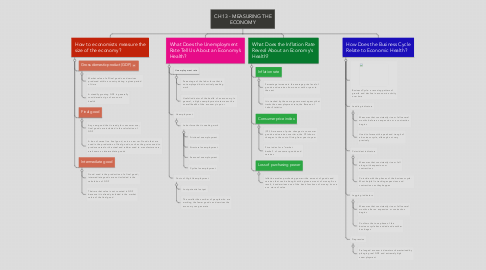
1. What Does the Unemployment Rate Tell Us About an Economy’s Health?
1.1. Unemployment rate
1.1.1. Percentage of the labor force that is not employed but is actively seeking work
1.1.2. Useful indicator of the health of an economy. In general, a high unemployment rate means the overall health of the economy is poor
1.2. Unemployment
1.2.1. Labor force that is seeking work
1.2.1.1. Frictional unemployment
1.2.1.2. Structural unemployment
1.2.1.3. Seasonal unemployment
1.2.1.4. Cyclical unemployment
1.3. Costs of High Unemployment
1.3.1. Lost potential output
1.3.2. The smaller the number of people who are working, the fewer goods and services the economy can generate
2. How Does the Business Cycle Relate to Economic Health?
2.1. Business Cycle: a recurring pattern of growth and decline in economic activity over time
2.2. Leading indicators
2.2.1. Measures that consistently rise or fall several months before an expansion or a contraction begins
2.2.2. Used to forecast the peak and trough of a business cycle, although not very precisely
2.3. Coincident indicators
2.3.1. Measures that consistently rise or fall along with expansions or contractions
2.3.2. Coincide with the phases of the business cycle. Most helpful in tracking expansions and contractions as they happen
2.4. Lagging indicators
2.4.1. Measures that consistently rise or fall several months after an expansion or contraction begins
2.4.2. Confirms that one phase of the business cycle has ended and another has begun
2.5. Depression
2.5.1. Prolonged economic downturn characterized by plunging real GDP and extremely high unemployment
3. What Does the Inflation Rate Reveal About an Economy’s Health?
3.1. Inflation rate
3.1.1. Percentage increase in the average price level of goods and services from one month or year to the next
3.1.2. It is tracked by the same government agency that tracks the unemployment rate, the Bureau of Labor Statistics
3.2. Consumer price index
3.2.1. (CPI) A measure of price changes in consumer goods and services over time; the CPI shows changes in the cost of living from year to year
3.2.2. Price index for a “market basket” of consumer goods and services
3.3. Loss of purchasing power
3.3.1. Inflation erodes purchasing power—the amount of goods and services that can be bought with a given amount of money. As a result, it undermines one of the basic functions of money: its use as a store of value
4. How to economists measure the size of the economy?
4.1. Gross domestic product (GDP)
4.1.1. Market value of all final goods and services produced within a country during a given period of time
4.1.2. A steadily growing GDP is generally considered a sign of economic health
4.2. Final good
4.2.1. Any new good that is ready for consumer use; final goods are included in the calculation of GDP
4.2.2. A box of cereal is a final good, as is a new car. Goods that are used in the production of final goods, such as the grains used to produce cereal or the steel and rubber used to manufacture cars, are known as intermediate goods
4.3. Intermediate good
4.3.1. Good used in the production of a final good; intermediate goods are not included in the calculation of GDP
4.3.2. Their market value is not counted in GDP because it is already included in the market value of the final good
